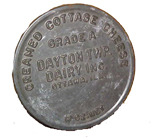Contact Us
By email:
info@one-place-studies.org
By post:
Society for One-Place Studies,
28 St Ronan’s Avenue,
Southsea, Hampshire, PO4 0QE
United Kingdom
This April we are once again blogging along with the A-Z Blogging Challenge. Our team of one-place studiers will be sharing some of the treasures to be found for a one-place study, particularly around the theme of Visualisation, our Shared Endeavour for 2016.
 B is for Bottle.
B is for Bottle.
 Milk bottle, that is.
Milk bottle, that is.
Farmers throughout the Dayton area sold their milk to the Dayton Dairy. In the early days of the twentieth century, the Green farm at Dayton had one of the oldest Jersey herds in the state of Illinois. Lyle A. Green, who took over the farm on the death of his father, Isaac, upgraded the herd until many of the cows made their way into the Jersey Registry of Merit. He traveled, often into neighboring states, to purchase pedigreed stock to improve the herd. He became a breeder, building a good reputation for Greenacres Farm of Dayton, Illinois.
 The names of the cows give some hint of the status of these ladies: Poppy Golden Oxford, Royal Mary's Design, and Belle's Golden Finance were surely belle dames of the dairy world. Raleigh's Meg, Raleigh's Ota and Raleigh's Lady Brookhill all gave evidence in their names of their descent from Raleigh's Lord Brookhill, who sired many prolific daughters for Lyle Green's breeding program.
The names of the cows give some hint of the status of these ladies: Poppy Golden Oxford, Royal Mary's Design, and Belle's Golden Finance were surely belle dames of the dairy world. Raleigh's Meg, Raleigh's Ota and Raleigh's Lady Brookhill all gave evidence in their names of their descent from Raleigh's Lord Brookhill, who sired many prolific daughters for Lyle Green's breeding program.
Despite the use of milking machines, the milking was still finished by hand, and the barn cats were adept at catching their daily ration of fresh milk. The cows were pastured in fields on the east side of the Fox river and twice a day the herd made its slow way across the bridge. After Lyle Green's death, his brother, Ralph, took over the farm and soon took his son-in-law, Charles Clifford, into partnership.

As you can see, the Green herd was sold in 1944 and, although the Dayton Dairy continued for some years, it, too, is no longer. The milk bottles are now only found at flea markets or on eBay, but they serve as a reminder of one of the major enterprises in Dayton in the first half of the twentieth century.
Candace Wilmot
4 Comments
Joseph Ditta
Wonderful, Candace! How do you know the names of the cows? They’re recorded somewhere, obviously, but I’m curious to know on what sort of document.
Candace Wilmot
The American Jersey Cattle Association maintained a Register of Merit of all Jersey cows that produced milk that met their test standards – percent butterfat, pounds of milk per day/month/year, etc. These published books listed the cows by name, as well as listing their their sire and dam, sometimes back for many generations. I also found several hand drawn lineage charts on a few of the cows in some of our family papers. For fun, I entered the cows in my genealogy software to draw pedigree charts.
Lori
Wow, Candace.. this was a fascinating read. I enjoyed learning the history behind all of this. I have an aunt who collects old milk bottles
Best Wishes,
Lori
Lori’s A2Zs @ https://asthefateswouldhaveit.wordpress.com/ & https://promptlywritten.wordpress.com/
Joseph Ditta
All I can say is (wait for it . . . ) Holy Cow!